University Financial Accounting Assignment Solution and Analysis
VerifiedAdded on 2020/05/11
|13
|1589
|45
Homework Assignment
AI Summary
This document presents a comprehensive solution to an advanced financial accounting assignment. It begins by addressing depreciation, outlining the necessary information for a new accountant to compute it, including date placed in service, acquisition value, salvage value, estimated useful life, and depreciation methods. The assignment then proceeds with detailed journal entries for specific scenarios involving property, plant, and equipment, followed by an in-depth analysis of contract accounting, comparing the percentage-of-completion method and the completed contract method. The solution further explores goodwill and impairment losses, providing journal entries and calculations. The assignment incorporates various financial accounting concepts and principles, offering a complete and practical guide to solving complex financial accounting problems.
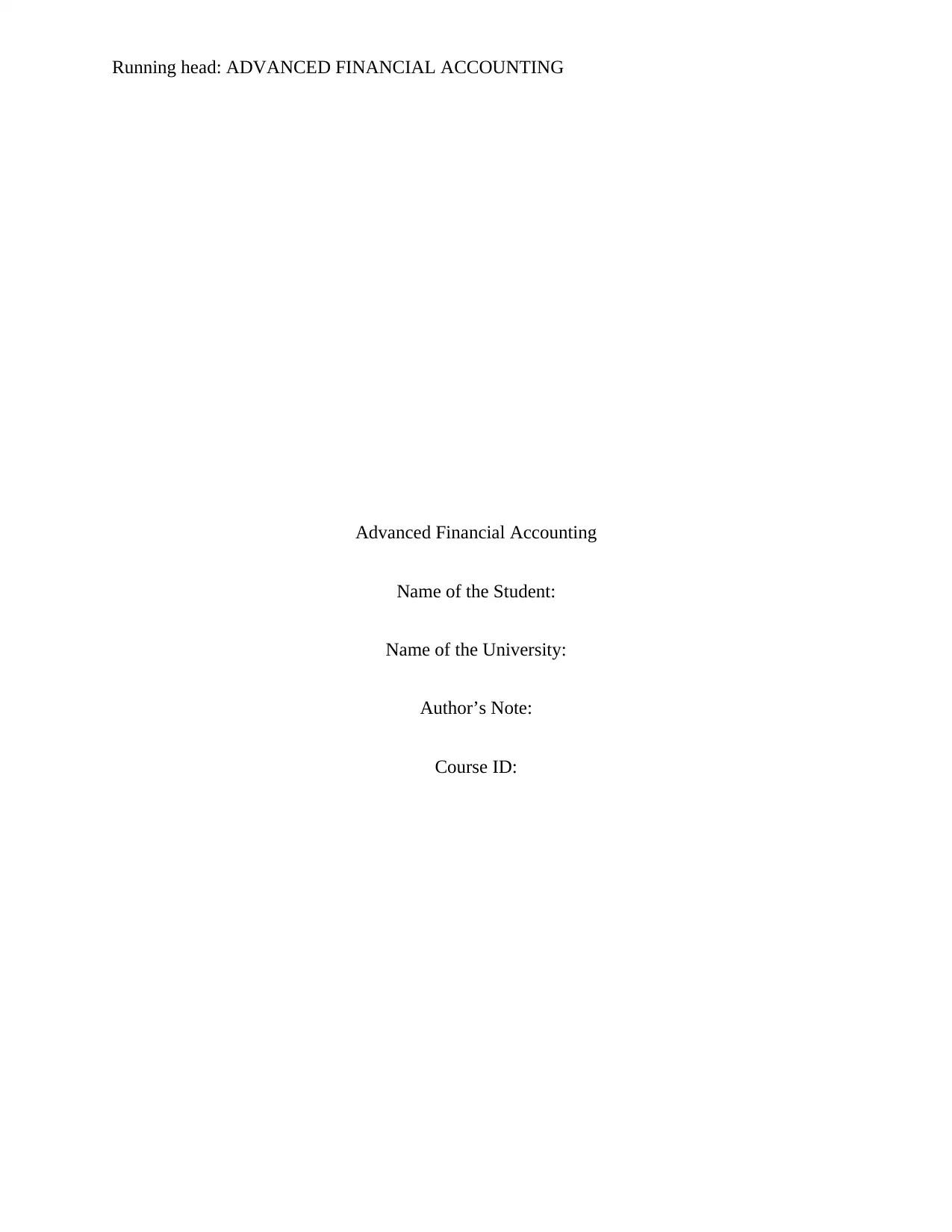
Running head: ADVANCED FINANCIAL ACCOUNTING
Advanced Financial Accounting
Name of the Student:
Name of the University:
Author’s Note:
Course ID:
Advanced Financial Accounting
Name of the Student:
Name of the University:
Author’s Note:
Course ID:
Paraphrase This Document
Need a fresh take? Get an instant paraphrase of this document with our AI Paraphraser
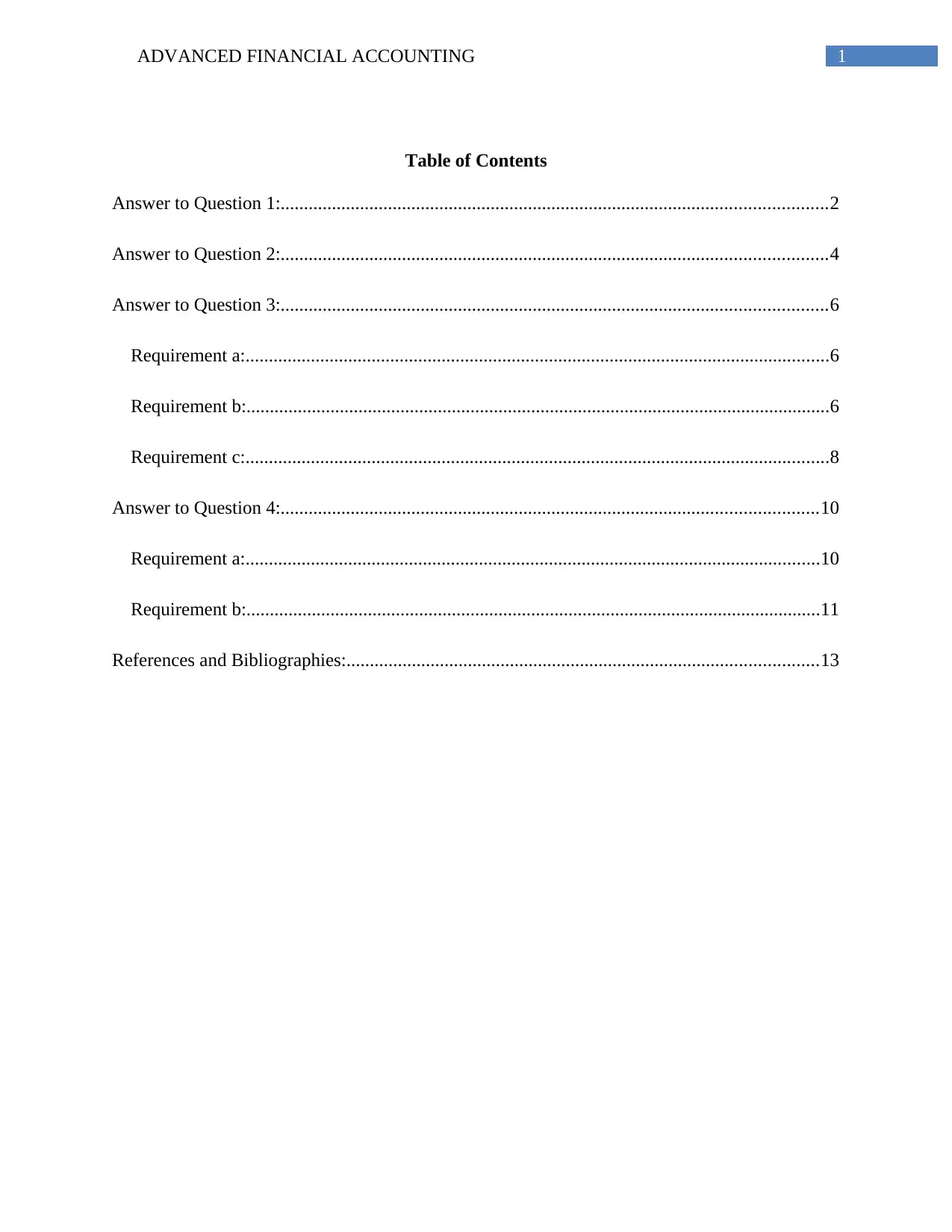
1ADVANCED FINANCIAL ACCOUNTING
Table of Contents
Answer to Question 1:.....................................................................................................................2
Answer to Question 2:.....................................................................................................................4
Answer to Question 3:.....................................................................................................................6
Requirement a:.............................................................................................................................6
Requirement b:.............................................................................................................................6
Requirement c:.............................................................................................................................8
Answer to Question 4:...................................................................................................................10
Requirement a:...........................................................................................................................10
Requirement b:...........................................................................................................................11
References and Bibliographies:.....................................................................................................13
Table of Contents
Answer to Question 1:.....................................................................................................................2
Answer to Question 2:.....................................................................................................................4
Answer to Question 3:.....................................................................................................................6
Requirement a:.............................................................................................................................6
Requirement b:.............................................................................................................................6
Requirement c:.............................................................................................................................8
Answer to Question 4:...................................................................................................................10
Requirement a:...........................................................................................................................10
Requirement b:...........................................................................................................................11
References and Bibliographies:.....................................................................................................13
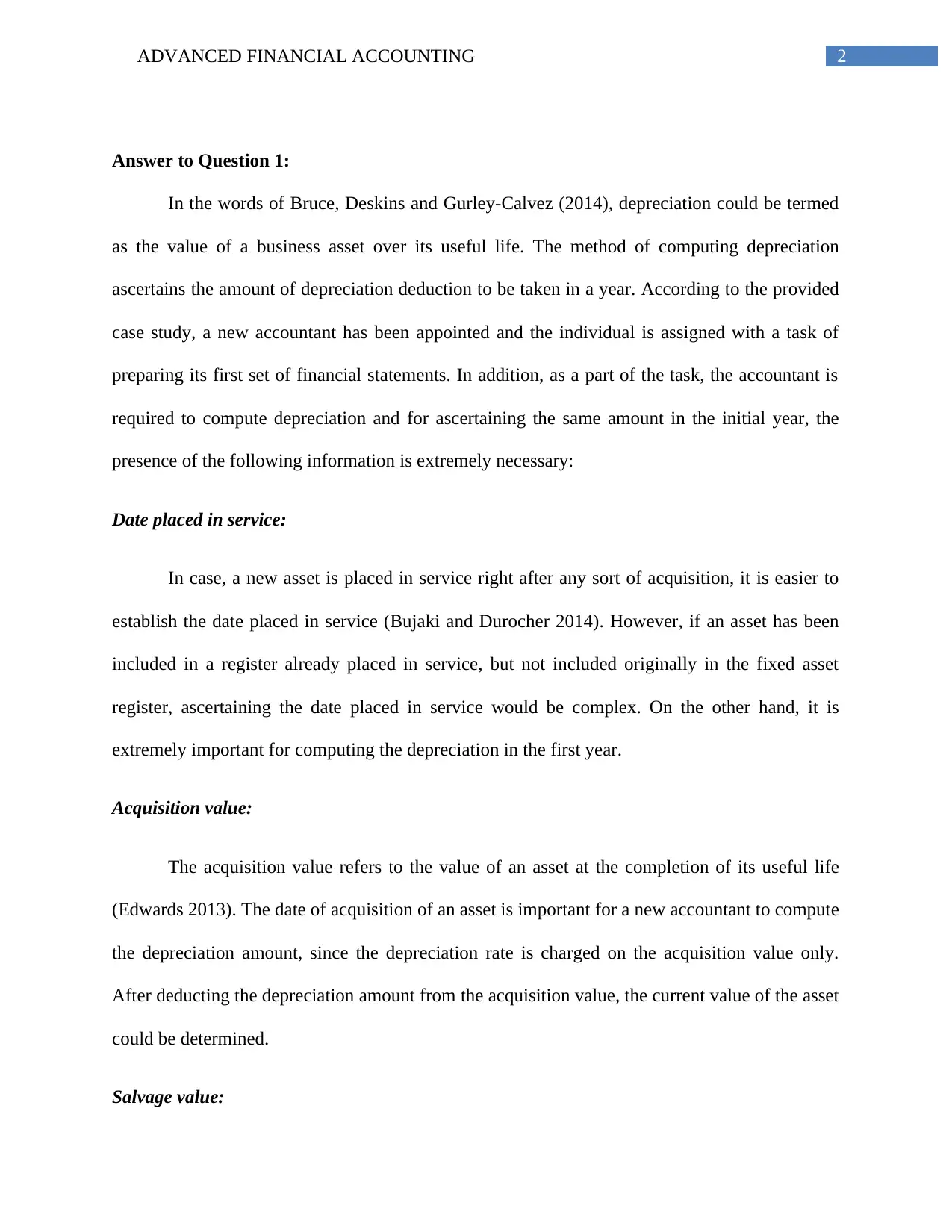
2ADVANCED FINANCIAL ACCOUNTING
Answer to Question 1:
In the words of Bruce, Deskins and Gurley-Calvez (2014), depreciation could be termed
as the value of a business asset over its useful life. The method of computing depreciation
ascertains the amount of depreciation deduction to be taken in a year. According to the provided
case study, a new accountant has been appointed and the individual is assigned with a task of
preparing its first set of financial statements. In addition, as a part of the task, the accountant is
required to compute depreciation and for ascertaining the same amount in the initial year, the
presence of the following information is extremely necessary:
Date placed in service:
In case, a new asset is placed in service right after any sort of acquisition, it is easier to
establish the date placed in service (Bujaki and Durocher 2014). However, if an asset has been
included in a register already placed in service, but not included originally in the fixed asset
register, ascertaining the date placed in service would be complex. On the other hand, it is
extremely important for computing the depreciation in the first year.
Acquisition value:
The acquisition value refers to the value of an asset at the completion of its useful life
(Edwards 2013). The date of acquisition of an asset is important for a new accountant to compute
the depreciation amount, since the depreciation rate is charged on the acquisition value only.
After deducting the depreciation amount from the acquisition value, the current value of the asset
could be determined.
Salvage value:
Answer to Question 1:
In the words of Bruce, Deskins and Gurley-Calvez (2014), depreciation could be termed
as the value of a business asset over its useful life. The method of computing depreciation
ascertains the amount of depreciation deduction to be taken in a year. According to the provided
case study, a new accountant has been appointed and the individual is assigned with a task of
preparing its first set of financial statements. In addition, as a part of the task, the accountant is
required to compute depreciation and for ascertaining the same amount in the initial year, the
presence of the following information is extremely necessary:
Date placed in service:
In case, a new asset is placed in service right after any sort of acquisition, it is easier to
establish the date placed in service (Bujaki and Durocher 2014). However, if an asset has been
included in a register already placed in service, but not included originally in the fixed asset
register, ascertaining the date placed in service would be complex. On the other hand, it is
extremely important for computing the depreciation in the first year.
Acquisition value:
The acquisition value refers to the value of an asset at the completion of its useful life
(Edwards 2013). The date of acquisition of an asset is important for a new accountant to compute
the depreciation amount, since the depreciation rate is charged on the acquisition value only.
After deducting the depreciation amount from the acquisition value, the current value of the asset
could be determined.
Salvage value:
⊘ This is a preview!⊘
Do you want full access?
Subscribe today to unlock all pages.

Trusted by 1+ million students worldwide
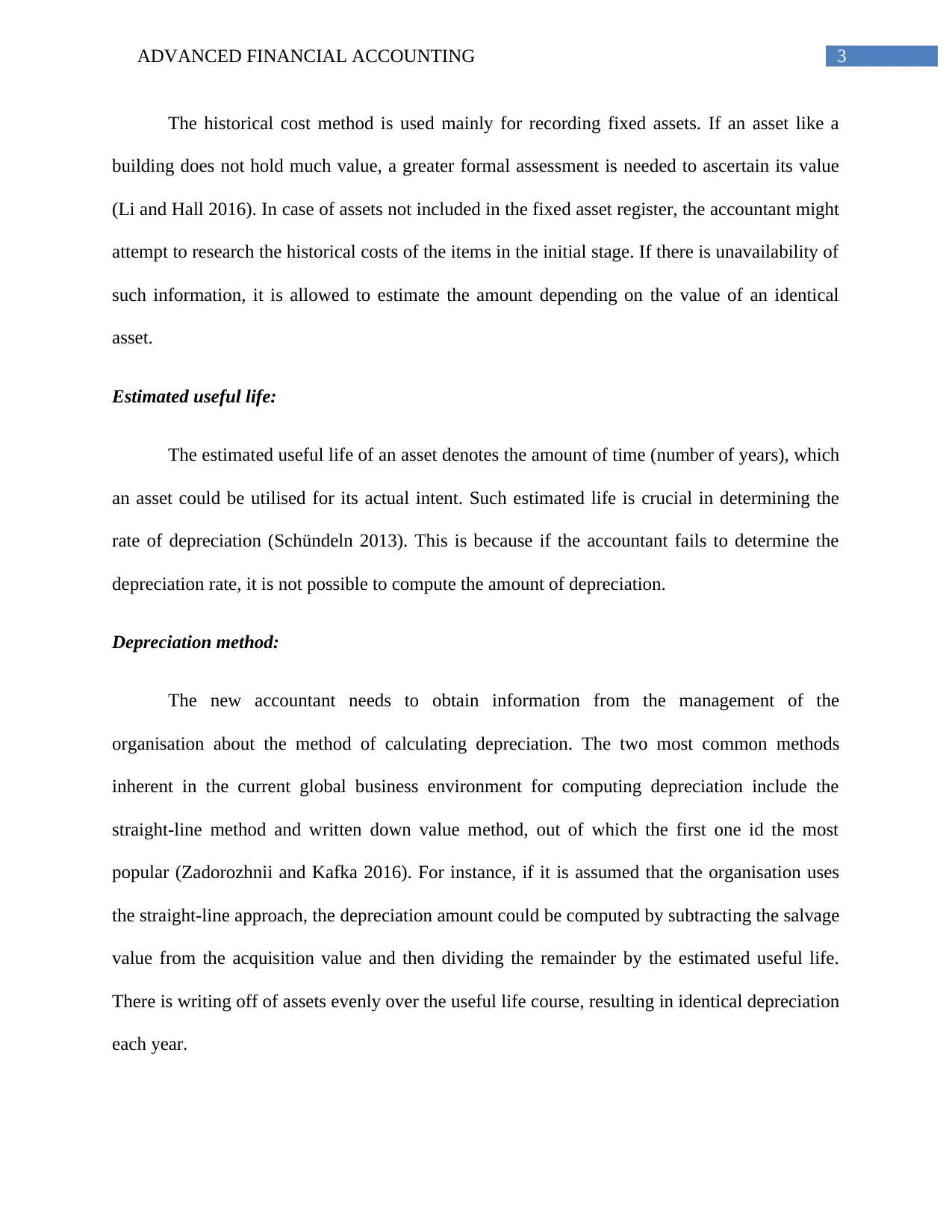
3ADVANCED FINANCIAL ACCOUNTING
The historical cost method is used mainly for recording fixed assets. If an asset like a
building does not hold much value, a greater formal assessment is needed to ascertain its value
(Li and Hall 2016). In case of assets not included in the fixed asset register, the accountant might
attempt to research the historical costs of the items in the initial stage. If there is unavailability of
such information, it is allowed to estimate the amount depending on the value of an identical
asset.
Estimated useful life:
The estimated useful life of an asset denotes the amount of time (number of years), which
an asset could be utilised for its actual intent. Such estimated life is crucial in determining the
rate of depreciation (Schündeln 2013). This is because if the accountant fails to determine the
depreciation rate, it is not possible to compute the amount of depreciation.
Depreciation method:
The new accountant needs to obtain information from the management of the
organisation about the method of calculating depreciation. The two most common methods
inherent in the current global business environment for computing depreciation include the
straight-line method and written down value method, out of which the first one id the most
popular (Zadorozhnii and Kafka 2016). For instance, if it is assumed that the organisation uses
the straight-line approach, the depreciation amount could be computed by subtracting the salvage
value from the acquisition value and then dividing the remainder by the estimated useful life.
There is writing off of assets evenly over the useful life course, resulting in identical depreciation
each year.
The historical cost method is used mainly for recording fixed assets. If an asset like a
building does not hold much value, a greater formal assessment is needed to ascertain its value
(Li and Hall 2016). In case of assets not included in the fixed asset register, the accountant might
attempt to research the historical costs of the items in the initial stage. If there is unavailability of
such information, it is allowed to estimate the amount depending on the value of an identical
asset.
Estimated useful life:
The estimated useful life of an asset denotes the amount of time (number of years), which
an asset could be utilised for its actual intent. Such estimated life is crucial in determining the
rate of depreciation (Schündeln 2013). This is because if the accountant fails to determine the
depreciation rate, it is not possible to compute the amount of depreciation.
Depreciation method:
The new accountant needs to obtain information from the management of the
organisation about the method of calculating depreciation. The two most common methods
inherent in the current global business environment for computing depreciation include the
straight-line method and written down value method, out of which the first one id the most
popular (Zadorozhnii and Kafka 2016). For instance, if it is assumed that the organisation uses
the straight-line approach, the depreciation amount could be computed by subtracting the salvage
value from the acquisition value and then dividing the remainder by the estimated useful life.
There is writing off of assets evenly over the useful life course, resulting in identical depreciation
each year.
Paraphrase This Document
Need a fresh take? Get an instant paraphrase of this document with our AI Paraphraser
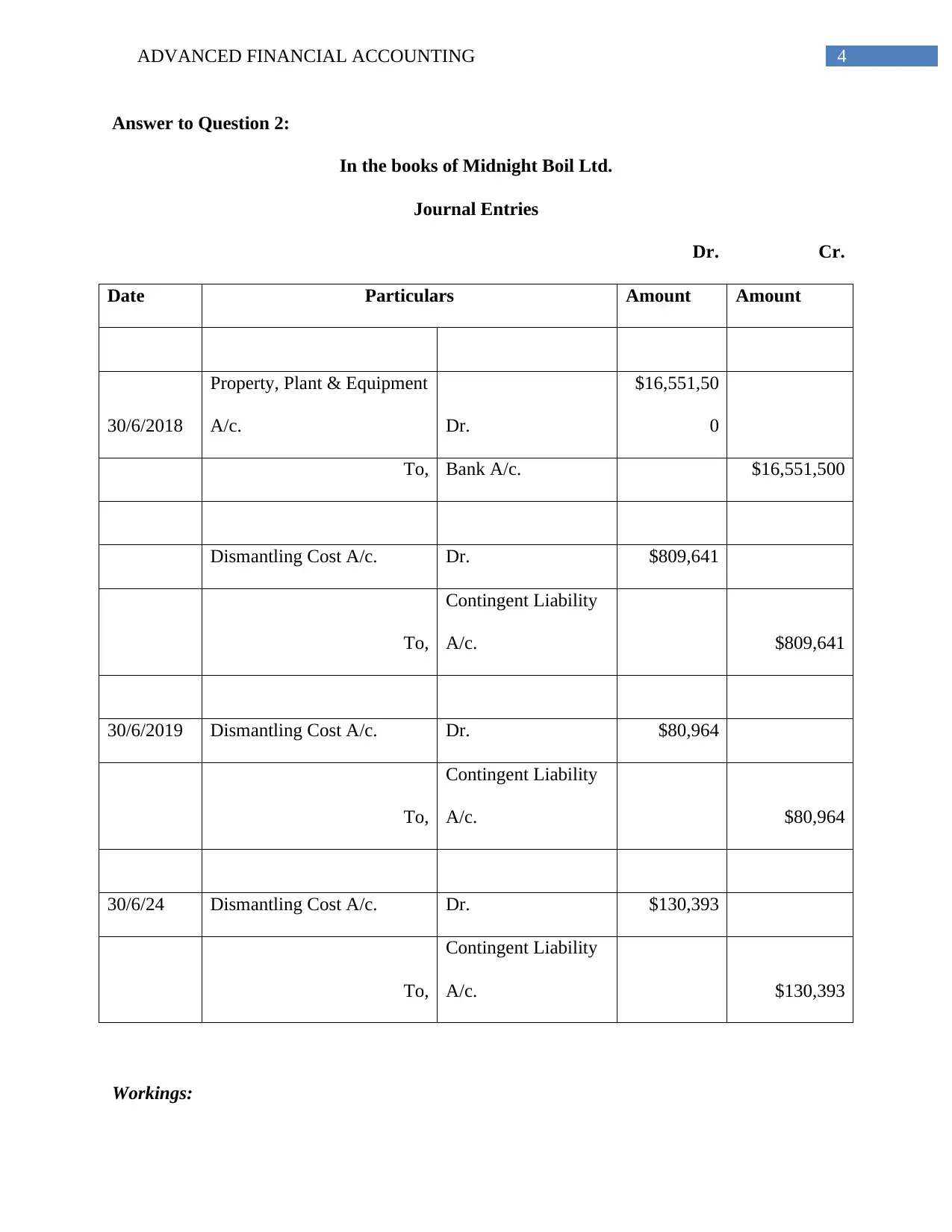
4ADVANCED FINANCIAL ACCOUNTING
Answer to Question 2:
In the books of Midnight Boil Ltd.
Journal Entries
Dr. Cr.
Date Particulars Amount Amount
30/6/2018
Property, Plant & Equipment
A/c. Dr.
$16,551,50
0
To, Bank A/c. $16,551,500
Dismantling Cost A/c. Dr. $809,641
To,
Contingent Liability
A/c. $809,641
30/6/2019 Dismantling Cost A/c. Dr. $80,964
To,
Contingent Liability
A/c. $80,964
30/6/24 Dismantling Cost A/c. Dr. $130,393
To,
Contingent Liability
A/c. $130,393
Workings:
Answer to Question 2:
In the books of Midnight Boil Ltd.
Journal Entries
Dr. Cr.
Date Particulars Amount Amount
30/6/2018
Property, Plant & Equipment
A/c. Dr.
$16,551,50
0
To, Bank A/c. $16,551,500
Dismantling Cost A/c. Dr. $809,641
To,
Contingent Liability
A/c. $809,641
30/6/2019 Dismantling Cost A/c. Dr. $80,964
To,
Contingent Liability
A/c. $80,964
30/6/24 Dismantling Cost A/c. Dr. $130,393
To,
Contingent Liability
A/c. $130,393
Workings:
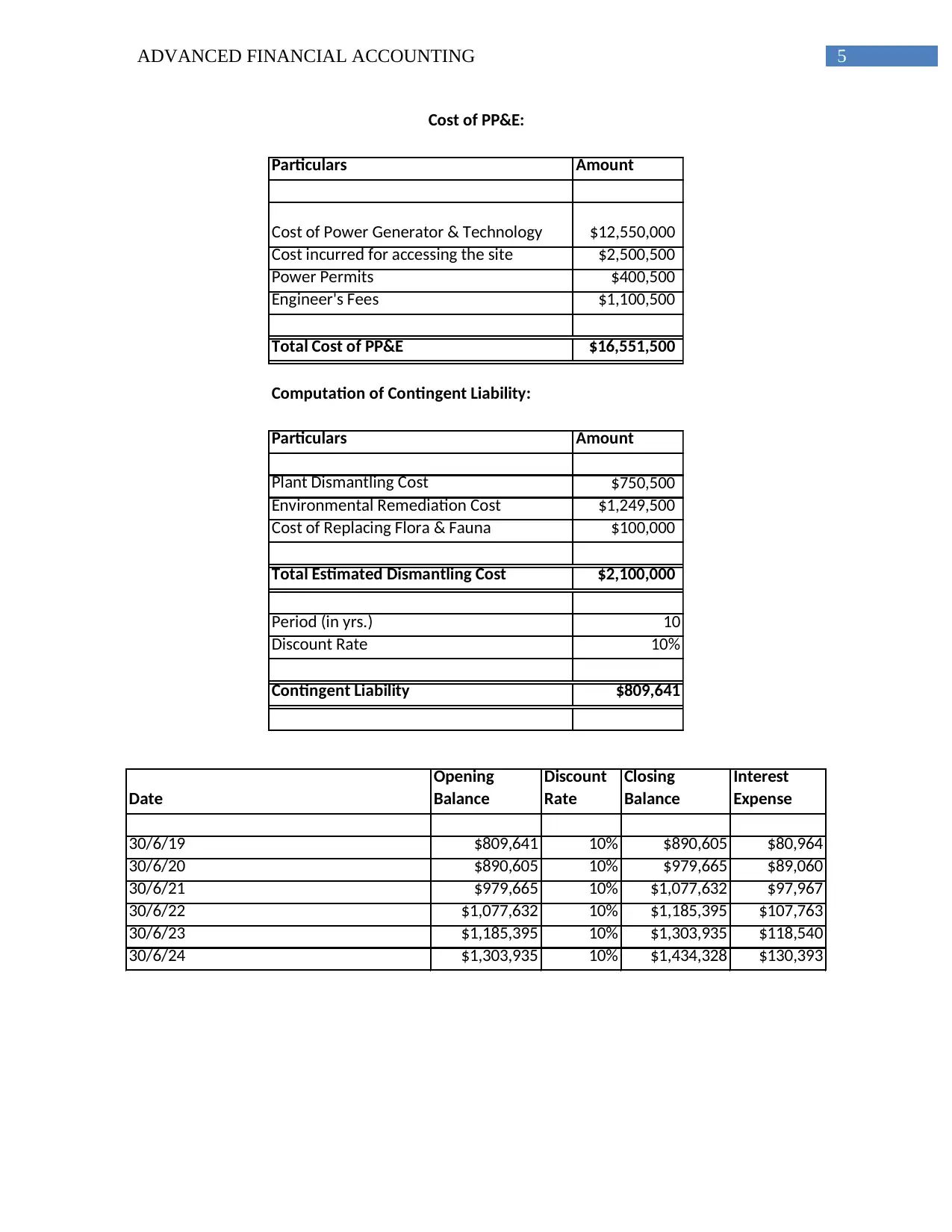
5ADVANCED FINANCIAL ACCOUNTING
Particulars Amount
Cost of Power Generator & Technology $12,550,000
Cost incurred for accessing the site $2,500,500
Power Permits $400,500
Engineer's Fees $1,100,500
Total Cost of PP&E $16,551,500
Computation of Contingent Liability:
Particulars Amount
Plant Dismantling Cost $750,500
Environmental Remediation Cost $1,249,500
Cost of Replacing Flora & Fauna $100,000
Total Estimated Dismantling Cost $2,100,000
Period (in yrs.) 10
Discount Rate 10%
Contingent Liability $809,641
Cost of PP&E:
Date
Opening
Balance
Discount
Rate
Closing
Balance
Interest
Expense
30/6/19 $809,641 10% $890,605 $80,964
30/6/20 $890,605 10% $979,665 $89,060
30/6/21 $979,665 10% $1,077,632 $97,967
30/6/22 $1,077,632 10% $1,185,395 $107,763
30/6/23 $1,185,395 10% $1,303,935 $118,540
30/6/24 $1,303,935 10% $1,434,328 $130,393
Particulars Amount
Cost of Power Generator & Technology $12,550,000
Cost incurred for accessing the site $2,500,500
Power Permits $400,500
Engineer's Fees $1,100,500
Total Cost of PP&E $16,551,500
Computation of Contingent Liability:
Particulars Amount
Plant Dismantling Cost $750,500
Environmental Remediation Cost $1,249,500
Cost of Replacing Flora & Fauna $100,000
Total Estimated Dismantling Cost $2,100,000
Period (in yrs.) 10
Discount Rate 10%
Contingent Liability $809,641
Cost of PP&E:
Date
Opening
Balance
Discount
Rate
Closing
Balance
Interest
Expense
30/6/19 $809,641 10% $890,605 $80,964
30/6/20 $890,605 10% $979,665 $89,060
30/6/21 $979,665 10% $1,077,632 $97,967
30/6/22 $1,077,632 10% $1,185,395 $107,763
30/6/23 $1,185,395 10% $1,303,935 $118,540
30/6/24 $1,303,935 10% $1,434,328 $130,393
⊘ This is a preview!⊘
Do you want full access?
Subscribe today to unlock all pages.

Trusted by 1+ million students worldwide
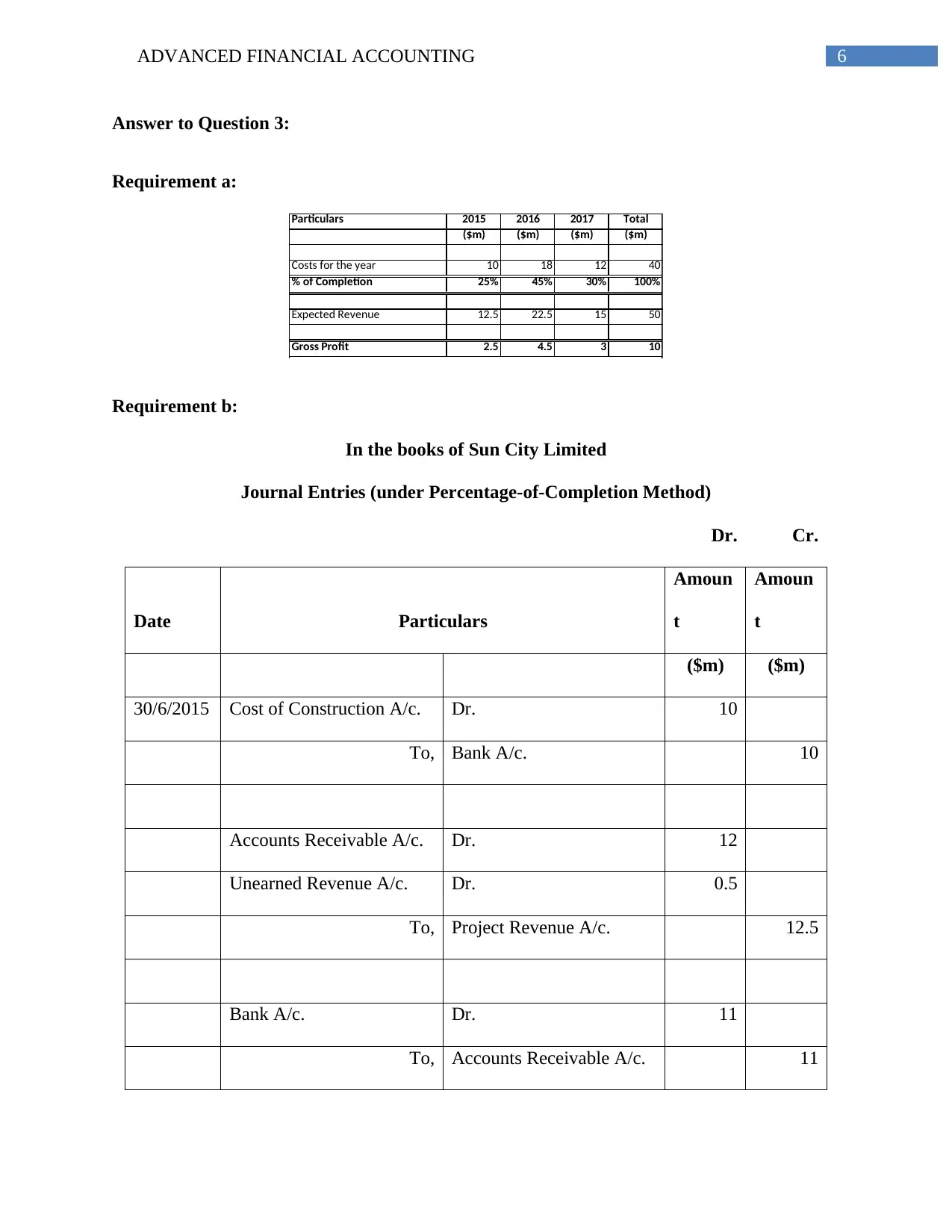
6ADVANCED FINANCIAL ACCOUNTING
Answer to Question 3:
Requirement a:
Particulars 2015 2016 2017 Total
($m) ($m) ($m) ($m)
Costs for the year 10 18 12 40
% of Completion 25% 45% 30% 100%
Expected Revenue 12.5 22.5 15 50
Gross Profit 2.5 4.5 3 10
Requirement b:
In the books of Sun City Limited
Journal Entries (under Percentage-of-Completion Method)
Dr. Cr.
Date Particulars
Amoun
t
Amoun
t
($m) ($m)
30/6/2015 Cost of Construction A/c. Dr. 10
To, Bank A/c. 10
Accounts Receivable A/c. Dr. 12
Unearned Revenue A/c. Dr. 0.5
To, Project Revenue A/c. 12.5
Bank A/c. Dr. 11
To, Accounts Receivable A/c. 11
Answer to Question 3:
Requirement a:
Particulars 2015 2016 2017 Total
($m) ($m) ($m) ($m)
Costs for the year 10 18 12 40
% of Completion 25% 45% 30% 100%
Expected Revenue 12.5 22.5 15 50
Gross Profit 2.5 4.5 3 10
Requirement b:
In the books of Sun City Limited
Journal Entries (under Percentage-of-Completion Method)
Dr. Cr.
Date Particulars
Amoun
t
Amoun
t
($m) ($m)
30/6/2015 Cost of Construction A/c. Dr. 10
To, Bank A/c. 10
Accounts Receivable A/c. Dr. 12
Unearned Revenue A/c. Dr. 0.5
To, Project Revenue A/c. 12.5
Bank A/c. Dr. 11
To, Accounts Receivable A/c. 11
Paraphrase This Document
Need a fresh take? Get an instant paraphrase of this document with our AI Paraphraser
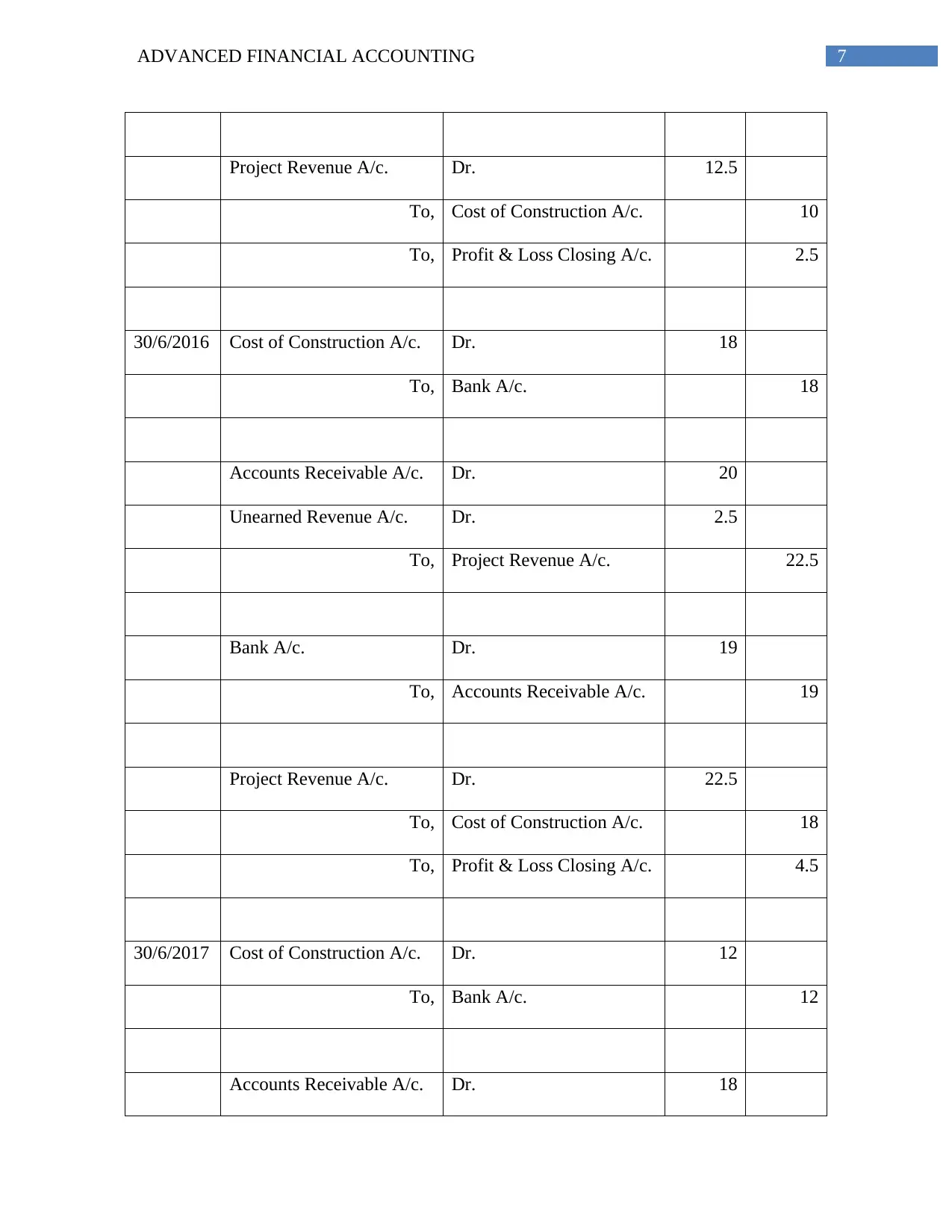
7ADVANCED FINANCIAL ACCOUNTING
Project Revenue A/c. Dr. 12.5
To, Cost of Construction A/c. 10
To, Profit & Loss Closing A/c. 2.5
30/6/2016 Cost of Construction A/c. Dr. 18
To, Bank A/c. 18
Accounts Receivable A/c. Dr. 20
Unearned Revenue A/c. Dr. 2.5
To, Project Revenue A/c. 22.5
Bank A/c. Dr. 19
To, Accounts Receivable A/c. 19
Project Revenue A/c. Dr. 22.5
To, Cost of Construction A/c. 18
To, Profit & Loss Closing A/c. 4.5
30/6/2017 Cost of Construction A/c. Dr. 12
To, Bank A/c. 12
Accounts Receivable A/c. Dr. 18
Project Revenue A/c. Dr. 12.5
To, Cost of Construction A/c. 10
To, Profit & Loss Closing A/c. 2.5
30/6/2016 Cost of Construction A/c. Dr. 18
To, Bank A/c. 18
Accounts Receivable A/c. Dr. 20
Unearned Revenue A/c. Dr. 2.5
To, Project Revenue A/c. 22.5
Bank A/c. Dr. 19
To, Accounts Receivable A/c. 19
Project Revenue A/c. Dr. 22.5
To, Cost of Construction A/c. 18
To, Profit & Loss Closing A/c. 4.5
30/6/2017 Cost of Construction A/c. Dr. 12
To, Bank A/c. 12
Accounts Receivable A/c. Dr. 18
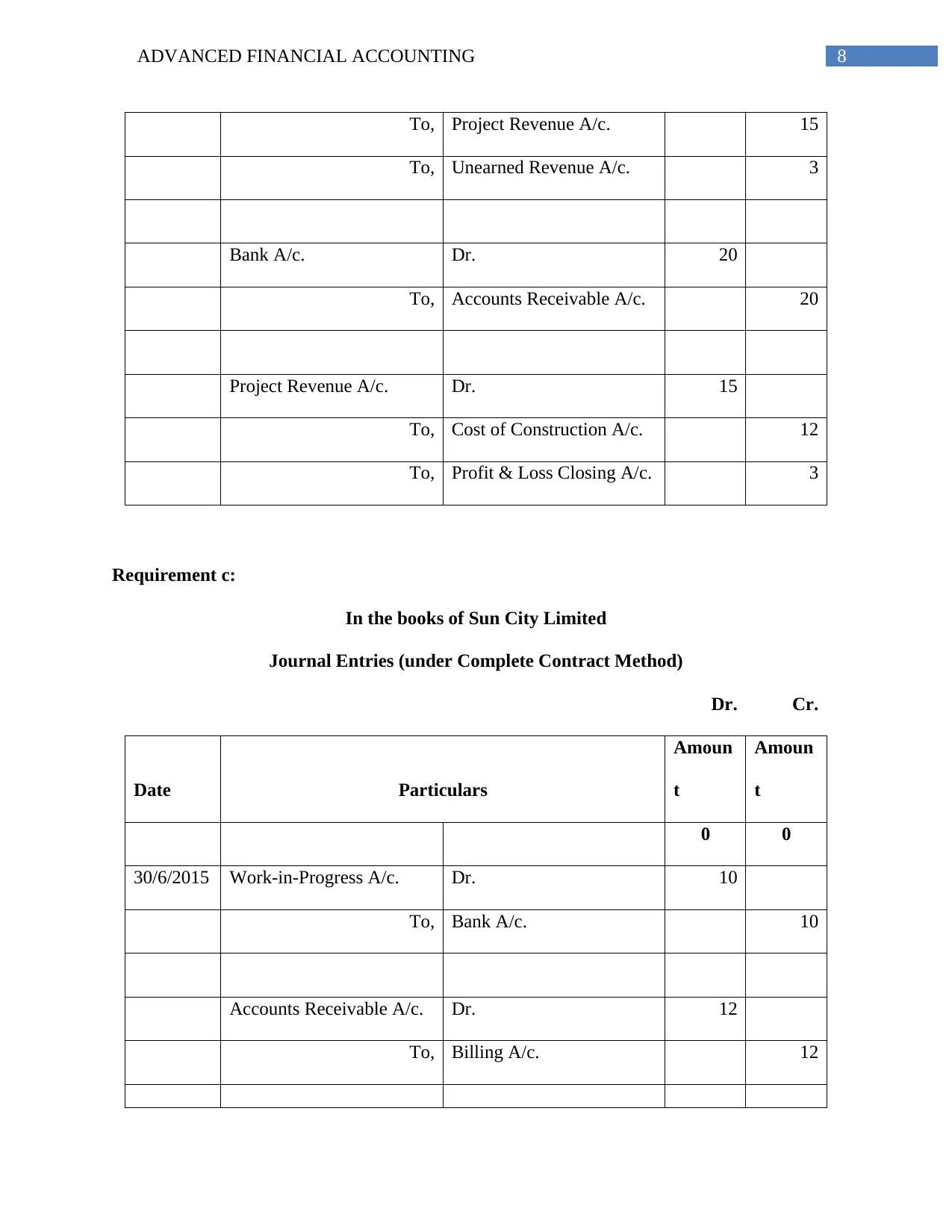
8ADVANCED FINANCIAL ACCOUNTING
To, Project Revenue A/c. 15
To, Unearned Revenue A/c. 3
Bank A/c. Dr. 20
To, Accounts Receivable A/c. 20
Project Revenue A/c. Dr. 15
To, Cost of Construction A/c. 12
To, Profit & Loss Closing A/c. 3
Requirement c:
In the books of Sun City Limited
Journal Entries (under Complete Contract Method)
Dr. Cr.
Date Particulars
Amoun
t
Amoun
t
0 0
30/6/2015 Work-in-Progress A/c. Dr. 10
To, Bank A/c. 10
Accounts Receivable A/c. Dr. 12
To, Billing A/c. 12
To, Project Revenue A/c. 15
To, Unearned Revenue A/c. 3
Bank A/c. Dr. 20
To, Accounts Receivable A/c. 20
Project Revenue A/c. Dr. 15
To, Cost of Construction A/c. 12
To, Profit & Loss Closing A/c. 3
Requirement c:
In the books of Sun City Limited
Journal Entries (under Complete Contract Method)
Dr. Cr.
Date Particulars
Amoun
t
Amoun
t
0 0
30/6/2015 Work-in-Progress A/c. Dr. 10
To, Bank A/c. 10
Accounts Receivable A/c. Dr. 12
To, Billing A/c. 12
⊘ This is a preview!⊘
Do you want full access?
Subscribe today to unlock all pages.

Trusted by 1+ million students worldwide
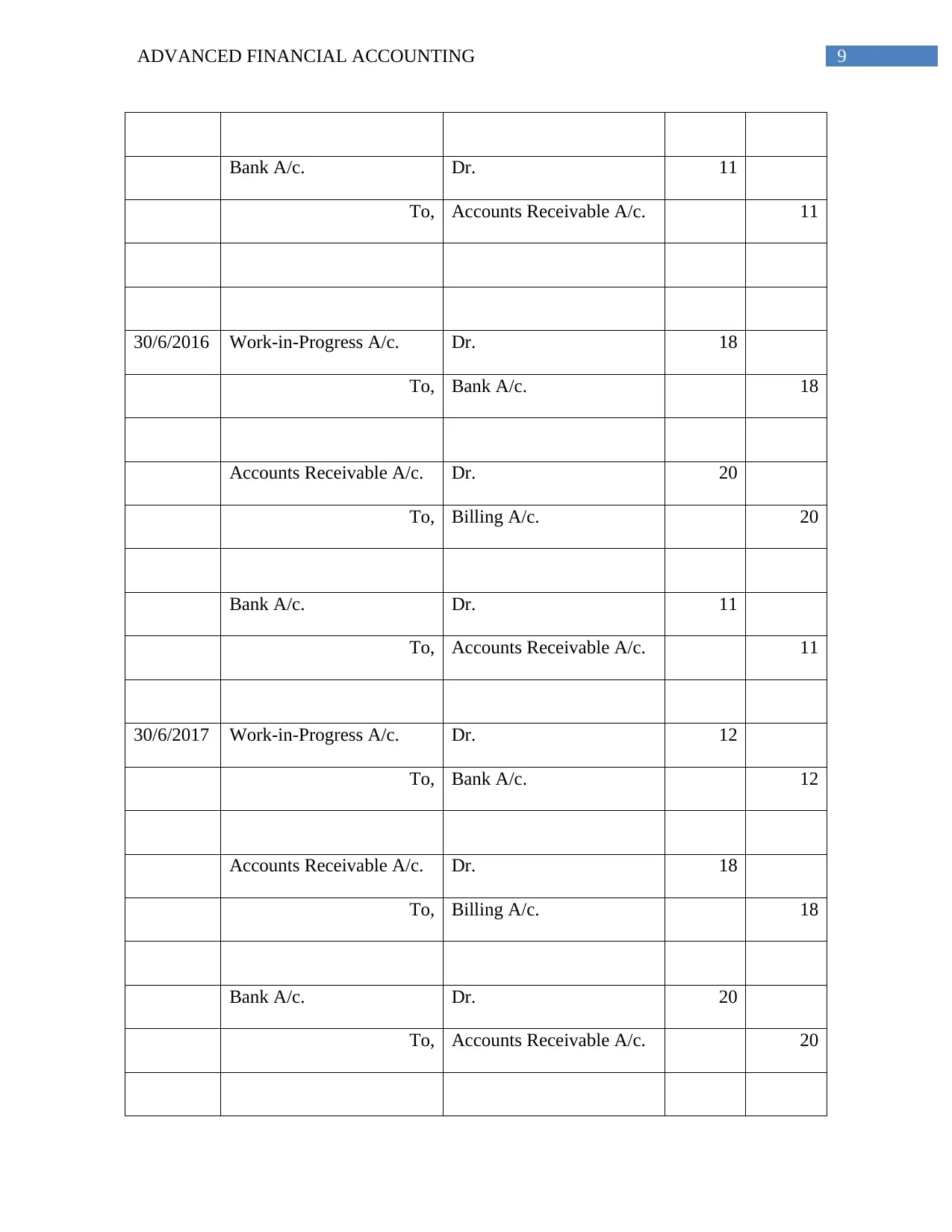
9ADVANCED FINANCIAL ACCOUNTING
Bank A/c. Dr. 11
To, Accounts Receivable A/c. 11
30/6/2016 Work-in-Progress A/c. Dr. 18
To, Bank A/c. 18
Accounts Receivable A/c. Dr. 20
To, Billing A/c. 20
Bank A/c. Dr. 11
To, Accounts Receivable A/c. 11
30/6/2017 Work-in-Progress A/c. Dr. 12
To, Bank A/c. 12
Accounts Receivable A/c. Dr. 18
To, Billing A/c. 18
Bank A/c. Dr. 20
To, Accounts Receivable A/c. 20
Bank A/c. Dr. 11
To, Accounts Receivable A/c. 11
30/6/2016 Work-in-Progress A/c. Dr. 18
To, Bank A/c. 18
Accounts Receivable A/c. Dr. 20
To, Billing A/c. 20
Bank A/c. Dr. 11
To, Accounts Receivable A/c. 11
30/6/2017 Work-in-Progress A/c. Dr. 12
To, Bank A/c. 12
Accounts Receivable A/c. Dr. 18
To, Billing A/c. 18
Bank A/c. Dr. 20
To, Accounts Receivable A/c. 20
Paraphrase This Document
Need a fresh take? Get an instant paraphrase of this document with our AI Paraphraser
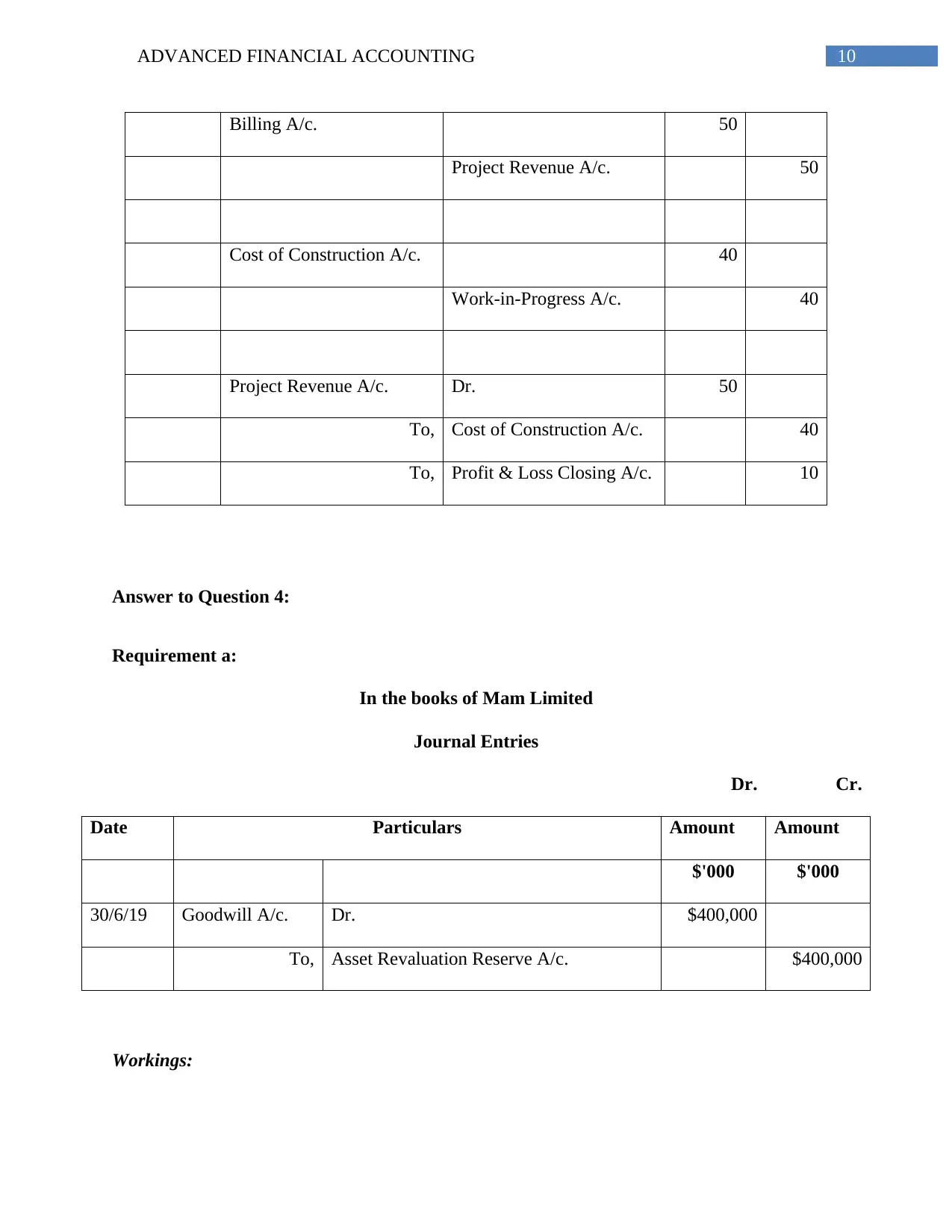
10ADVANCED FINANCIAL ACCOUNTING
Billing A/c. 50
Project Revenue A/c. 50
Cost of Construction A/c. 40
Work-in-Progress A/c. 40
Project Revenue A/c. Dr. 50
To, Cost of Construction A/c. 40
To, Profit & Loss Closing A/c. 10
Answer to Question 4:
Requirement a:
In the books of Mam Limited
Journal Entries
Dr. Cr.
Date Particulars Amount Amount
$'000 $'000
30/6/19 Goodwill A/c. Dr. $400,000
To, Asset Revaluation Reserve A/c. $400,000
Workings:
Billing A/c. 50
Project Revenue A/c. 50
Cost of Construction A/c. 40
Work-in-Progress A/c. 40
Project Revenue A/c. Dr. 50
To, Cost of Construction A/c. 40
To, Profit & Loss Closing A/c. 10
Answer to Question 4:
Requirement a:
In the books of Mam Limited
Journal Entries
Dr. Cr.
Date Particulars Amount Amount
$'000 $'000
30/6/19 Goodwill A/c. Dr. $400,000
To, Asset Revaluation Reserve A/c. $400,000
Workings:
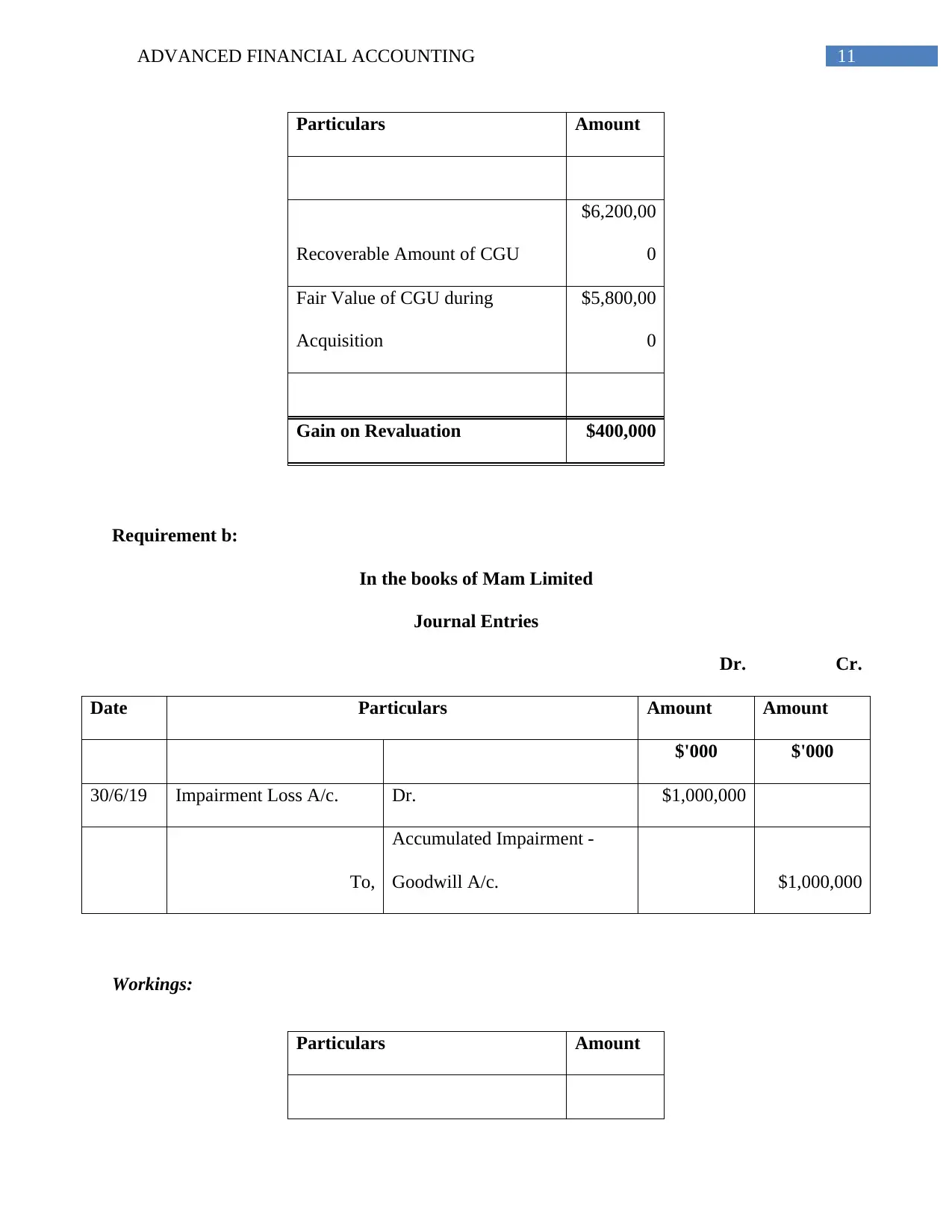
11ADVANCED FINANCIAL ACCOUNTING
Particulars Amount
Recoverable Amount of CGU
$6,200,00
0
Fair Value of CGU during
Acquisition
$5,800,00
0
Gain on Revaluation $400,000
Requirement b:
In the books of Mam Limited
Journal Entries
Dr. Cr.
Date Particulars Amount Amount
$'000 $'000
30/6/19 Impairment Loss A/c. Dr. $1,000,000
To,
Accumulated Impairment -
Goodwill A/c. $1,000,000
Workings:
Particulars Amount
Particulars Amount
Recoverable Amount of CGU
$6,200,00
0
Fair Value of CGU during
Acquisition
$5,800,00
0
Gain on Revaluation $400,000
Requirement b:
In the books of Mam Limited
Journal Entries
Dr. Cr.
Date Particulars Amount Amount
$'000 $'000
30/6/19 Impairment Loss A/c. Dr. $1,000,000
To,
Accumulated Impairment -
Goodwill A/c. $1,000,000
Workings:
Particulars Amount
⊘ This is a preview!⊘
Do you want full access?
Subscribe today to unlock all pages.

Trusted by 1+ million students worldwide
1 out of 13
Related Documents
Your All-in-One AI-Powered Toolkit for Academic Success.
+13062052269
info@desklib.com
Available 24*7 on WhatsApp / Email
![[object Object]](/_next/static/media/star-bottom.7253800d.svg)
Unlock your academic potential
Copyright © 2020–2025 A2Z Services. All Rights Reserved. Developed and managed by ZUCOL.





